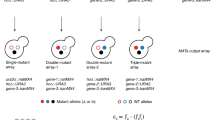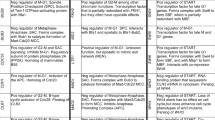Abstract
Global quantitative analysis of genetic interactions is a powerful approach for deciphering the roles of genes and mapping functional relationships among pathways. Using colony size as a proxy for fitness, we developed a method for measuring fitness-based genetic interactions from high-density arrays of yeast double mutants generated by synthetic genetic array (SGA) analysis. We identified several experimental sources of systematic variation and developed normalization strategies to obtain accurate single- and double-mutant fitness measurements, which rival the accuracy of other high-resolution studies. We applied the SGA score to examine the relationship between physical and genetic interaction networks, and we found that positive genetic interactions connect across functionally distinct protein complexes revealing a network of genetic suppression among loss-of-function alleles.
This is a preview of subscription content, access via your institution
Access options
Subscribe to this journal
Receive 12 print issues and online access
$259.00 per year
only $21.58 per issue
Buy this article
- Purchase on Springer Link
- Instant access to full article PDF
Prices may be subject to local taxes which are calculated during checkout






Similar content being viewed by others
References
Baryshnikova, A. et al. Synthetic genetic array (SGA) analysis in Saccharomyces cerevisiae and Schizosaccharomyces pombe . Methods Enzymol. 470, 146–180 (2010).
Dixon, S.J., Costanzo, M., Baryshnikova, A., Andrews, B. & Boone, C. Systematic mapping of genetic interaction networks. Annu. Rev. Genet. 470, 145–179 (2009).
Collins, S.R., Schuldiner, M., Krogan, N.J. & Weissman, J.S. A strategy for extracting and analyzing large-scale quantitative epistatic interaction data. Genome Biol. 7, R63 (2006).
Breslow, D.K. et al. A comprehensive strategy enabling high-resolution functional analysis of the yeast genome. Nat. Methods 5, 711–718 (2008).
St Onge, R.P. et al. Systematic pathway analysis using high-resolution fitness profiling of combinatorial gene deletions. Nat. Genet. 39, 199–206 (2007).
Avery, L. & Wasserman, S. Ordering gene function: the interpretation of epistasis in regulatory hierarchies. Trends Genet. 8, 312–316 (1992).
Costanzo, M. et al. The genetic landscape of a cell. Science 327, 425–431 (2010).
Drees, B.L. et al. Derivation of genetic interaction networks from quantitative phenotype data. Genome Biol. 6, R38 (2005).
Tong, A.H. et al. Global mapping of the yeast genetic interaction network. Science 303, 808–813 (2004).
Deutschbauer, A.M. et al. Mechanisms of haploinsufficiency revealed by genome-wide profiling in yeast. Genetics 169, 1915–1925 (2005).
Breitkreutz, B.J. et al. The BioGRID interaction database: 2008 update. Nucleic Acids Res. 36, D637–D640 (2008).
Myers, C.L., Barrett, D.R., Hibbs, M.A., Huttenhower, C. & Troyanskaya, O.G. Finding function: evaluation methods for functional genomic data. BMC Genomics 7, 187 (2006).
Bandyopadhyay, S., Kelley, R., Krogan, N.J. & Ideker, T. Functional maps of protein complexes from quantitative genetic interaction data. PLOS Comput. Biol. 4, e1000065 (2008).
Segre, D., Deluna, A., Church, G.M. & Kishony, R. Modular epistasis in yeast metabolism. Nat. Genet. 37, 77–83 (2005).
Ungar, D., Oka, T., Krieger, M. & Hughson, F.M. Retrograde transport on the COG railway. Trends Cell Biol. 16, 113–120 (2006).
Yu, H. et al. High-quality binary protein interaction map of the yeast interactome network. Science 322, 104–110 (2008).
Tarassov, K. et al. An in vivo map of the yeast protein interactome. Science 320, 1465–1470 (2008).
Gavin, A.C. et al. Proteome survey reveals modularity of the yeast cell machinery. Nature 440, 631–636 (2006).
Krogan, N.J. et al. Global landscape of protein complexes in the yeast Saccharomyces cerevisiae . Nature 440, 637–643 (2006).
Mitchell, A.P.A. VAST staging area for regulatory proteins. Proc. Natl. Acad. Sci. USA 105, 7111–7112 (2008).
Hayashi, M., Fukuzawa, T., Sorimachi, H. & Maeda, T. Constitutive activation of the pH-responsive Rim101 pathway in yeast mutants defective in late steps of the MVB/ESCRT pathway. Mol. Cell. Biol. 25, 9478–9490 (2005).
Barwell, K.J., Boysen, J.H., Xu, W. & Mitchell, A.P. Relationship of DFG16 to the Rim101p pH response pathway in Saccharomyces cerevisiae and Candida albicans. Eukaryot. Cell 4, 890–899 (2005).
Rothfels, K. et al. Components of the ESCRT pathway, DFG16, and YGR122w are required for Rim101 to act as a corepressor with Nrg1 at the negative regulatory element of the DIT1 gene of Saccharomyces cerevisiae . Mol. Cell. Biol. 25, 6772–6788 (2005).
Kemp, H.A. & Sprague, G.F. Jr. Far3 and five interacting proteins prevent premature recovery from pheromone arrest in the budding yeast Saccharomyces cerevisiae . Mol. Cell. Biol. 23, 1750–1763 (2003).
Goudreault, M. et al. A PP2A phosphatase high density interaction network identifies a novel striatin-interacting phosphatase and kinase complex linked to the cerebral cavernous malformation 3 (CCM3) protein. Mol. Cell. Proteomics 8, 157–171 (2009).
Posas, F. et al. The gene PPG encodes a novel yeast protein phosphatase involved in glycogen accumulation. J. Biol. Chem. 268, 1349–1354 (1993).
Van Driessche, N. et al. Epistasis analysis with global transcriptional phenotypes. Nat. Genet. 37, 471–477 (2005).
Dixon, S.J. et al. Significant conservation of synthetic lethal genetic interaction networks between distantly related eukaryotes. Proc. Natl. Acad. Sci. USA 105, 16653–16658 (2008).
Roguev, A. et al. Conservation and rewiring of functional modules revealed by an epistasis map in fission yeast. Science 322, 405–410 (2008).
Babu, M. et al. Systems-level approaches for identifying and analyzing genetic interaction networks in Escherichia coli and extensions to other prokaryotes. Mol. Biosyst. 5, 1439–1455 (2009).
Leek, J.T. et al. Tackling the widespread and critical impact of batch effects in high-throughput data. Nat. Rev. Genet. 11, 733–739 (2010).
He, X., Qian, W., Wang, Z., Li, Y. & Zhang, J. Prevalent positive epistasis in Escherichia coli and Saccharomyces cerevisiae metabolic networks. Nat. Genet. 42, 272–276 (2010).
Hughes, T.R. et al. Functional discovery via a compendium of expression profiles. Cell 102, 109–126 (2000).
Jasnos, L. & Korona, R. Epistatic buffering of fitness loss in yeast double deletion strains. Nat. Genet. 39, 550–554 (2007).
Warringer, J., Ericson, E., Fernandez, L., Nerman, O. & Blomberg, A. High-resolution yeast phenomics resolves different physiological features in the saline response. Proc. Natl. Acad. Sci. USA 100, 15724–15729 (2003).
Brauer, M.J. et al. Coordination of growth rate, cell cycle, stress response, and metabolic activity in yeast. Mol. Biol. Cell 19, 352–367 (2008).
Hartman, J.L.t. & Tippery, N.P. Systematic quantification of gene interactions by phenotypic array analysis. Genome Biol. 5, R49 (2004).
Friesen, H. et al. Characterization of the yeast amphiphysins Rvs161p and Rvs167p reveals roles for the Rvs heterodimer in vivo. Mol. Biol. Cell 17, 1306–1321 (2006).
Bellaoui, M. et al. Elg1 forms an alternative RFC complex important for DNA replication and genome integrity. EMBO J. 22, 4304–4313 (2003).
Stark, C. et al. BioGRID: a general repository for interaction datasets. Nucleic Acids Res. 34, D535–D539 (2006).
Acknowledgements
We thank R. Mani, F. Roth, B. Papp, T. Maeda and T. Hays for helpful discussions and critical comments. This work was supported by Genome Canada through the Ontario Genomics Institute (2004-OGI-3-01), the Canadian Institutes of Health Research (GSP-415-67; C.B. and B.A.) (MOP-79368; G.W.B.), the US National Institutes of Health (1R01HG005084-01A1; C.L.M., Y.K. and S.B.) and the National Science Foundation (DBI 0953881, MCB 0918908; C.L.M. and Y.K.) and partially supported by a seed grant from the Minnesota Supercomputing Institute (C.L.M. and Y.K.).
Author information
Authors and Affiliations
Contributions
M.C., C.L.M., C.B. and B.A. conceived and coordinated the project. C.L.M. and A.B. designed and implemented the algorithm. A.B., C.L.M., Y.K., J.K. and S.B. performed statistical analysis. J.-Y.Y., B.-J.S.L., J.O., G.W.B. and M.C. validated experiments. H.D. and K.T. analyzed and processed images. M.H., D.H., G.D.B. and O.G.T. provided statistical insight. A.-C.G. provided biological insight. M.C., C.L.M., C.B. and A.B. prepared the manuscript.
Corresponding authors
Ethics declarations
Competing interests
The authors declare no competing financial interests.
Supplementary information
Supplementary Text and Figures
Supplementary Figures 1–11, Supplementary Tables 1–3 and Supplementary Notes 1–6 (PDF 10244 kb)
Supplementary Data 1
Single-mutant fitness standard. (XLS 514 kb)
Supplementary Data 2
Protein complex standard. (XLS 207 kb)
Supplementary Data 3
List of complex-complex pairs enriched for positive genetic interactions. (XLS 179 kb)
Supplementary Software
Matlab source code for the SGA score algorithm. (ZIP 186 kb)
Rights and permissions
About this article
Cite this article
Baryshnikova, A., Costanzo, M., Kim, Y. et al. Quantitative analysis of fitness and genetic interactions in yeast on a genome scale. Nat Methods 7, 1017–1024 (2010). https://doi.org/10.1038/nmeth.1534
Received:
Accepted:
Published:
Issue Date:
DOI: https://doi.org/10.1038/nmeth.1534
This article is cited by
-
Multimodal perturbation analyses of cyclin-dependent kinases reveal a network of synthetic lethalities associated with cell-cycle regulation and transcriptional regulation
Scientific Reports (2023)
-
Resolving Deleterious and Near-Neutral Effects Requires Different Pooled Fitness Assay Designs
Journal of Molecular Evolution (2023)
-
ScreenGarden: a shinyR application for fast and easy analysis of plate-based high-throughput screens
BMC Bioinformatics (2022)
-
Lithium chloride sensitivity connects the activity of PEX11 and RIM20 to the translation of PGM2 and other mRNAs with structured 5’-UTRs
Molecular and Cellular Biochemistry (2022)
-
Protein kinase A controls yeast growth in visible light
BMC Biology (2020)



